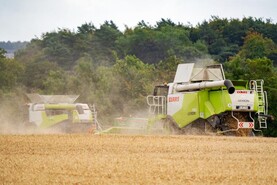Farmers have noticed an increase of up to €10/t on some animal feeds in recent days.
While there is plenty of supply available globally for most animal feed ingredients, COVID-19 is causing logistical issues for feed mills.
In particular, mills are reporting that there are shipping issues with soya, with ports in Brazil and Argentina slowed down as a result of workers becoming ill or continued Government uncertainty over the pandemic.
While ports in Ireland remain fully operational, there are also issues with the speed at which shipments can be unloaded, given that many teams have been downsized and split to comply with social distancing regulations.
This has meant that the price of soya has gone up €85/t in the last fortnight.
All of these delays generate pressure on the supply side, which has helped to push up the price of soya, as well as many other ingredients.
It is expected that prices will remain higher for the next two months or so.
Mid-proteins
The price of mid-proteins such as maize distillers could also be affected, not by the coronavirus but as a result of the low global crude oil price.
With oil prices at such low levels, it’s no longer economically viable to produce surplus bioethanol in the US and maize distillers, an ingredient in many animal feeds, is a by-product of bioethanol.
While the price of maize has decreased, the issue with slow supplies of other ingredients has pushed up the price of native grains.
Wheat has gone from €196/t to €205, while barley has gone up €5/t.
Pat Ryan of Liffey Feeds said that many mills had just come through their busiest 10 days of the year. He acknowledged that it was a difficult time for farmers.
“We’d hope that banks would be understanding to our customers during this time and not be rigid with people who have a good track record,” Ryan said.
Haulage costs are a growing problem, due to a combination of absent drivers and back loads, which are pushing up haulage price.
Read more
Coronavirus: new measures in place at Quinns
Lakeland Dairies rolls out new COVID-19 measures
Farmers have noticed an increase of up to €10/t on some animal feeds in recent days.
While there is plenty of supply available globally for most animal feed ingredients, COVID-19 is causing logistical issues for feed mills.
In particular, mills are reporting that there are shipping issues with soya, with ports in Brazil and Argentina slowed down as a result of workers becoming ill or continued Government uncertainty over the pandemic.
While ports in Ireland remain fully operational, there are also issues with the speed at which shipments can be unloaded, given that many teams have been downsized and split to comply with social distancing regulations.
This has meant that the price of soya has gone up €85/t in the last fortnight.
All of these delays generate pressure on the supply side, which has helped to push up the price of soya, as well as many other ingredients.
It is expected that prices will remain higher for the next two months or so.
Mid-proteins
The price of mid-proteins such as maize distillers could also be affected, not by the coronavirus but as a result of the low global crude oil price.
With oil prices at such low levels, it’s no longer economically viable to produce surplus bioethanol in the US and maize distillers, an ingredient in many animal feeds, is a by-product of bioethanol.
While the price of maize has decreased, the issue with slow supplies of other ingredients has pushed up the price of native grains.
Wheat has gone from €196/t to €205, while barley has gone up €5/t.
Pat Ryan of Liffey Feeds said that many mills had just come through their busiest 10 days of the year. He acknowledged that it was a difficult time for farmers.
“We’d hope that banks would be understanding to our customers during this time and not be rigid with people who have a good track record,” Ryan said.
Haulage costs are a growing problem, due to a combination of absent drivers and back loads, which are pushing up haulage price.
Read more
Coronavirus: new measures in place at Quinns
Lakeland Dairies rolls out new COVID-19 measures






 This is a subscriber-only article
This is a subscriber-only article










SHARING OPTIONS: